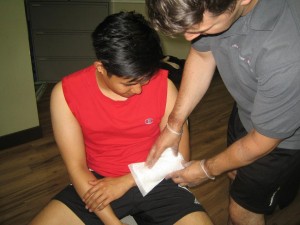When it comes to minor scratches and cuts while at work or during sports, they can be easily managed at home. As for large-sized wounds, they should be dressed until medical care is available. Always bear in mind that cleanliness is a vital point to remember in order to prevent infection from developing.
Steps in dressing a wound

- Always stay safe when helping out an individual by observing the universal precautions and use proper protective gear and equipment if available.
- Minimal bleeding can help since it flushes out dirt and other contaminants from the wound. You can control the bleeding by applying direct pressure over the wound using a clean cloth or gauze. You have to call for emergency assistance if there is bright red or gushing blood, deep puncture wound on the head, chest, neck, abdomen, back or pelvis and if there is a deep puncture wound on the arm above the elbow.
- Cleanse the wound using running water. Wash the skin around the injury site using soap. Do not worry if soap enters the wound, though it might sting and irritate the raw tissue. Rinse the wound carefully to eliminate any leftover dirt and soap. You can use tweezers to remove particles. Hydrogen peroxide is neither required nor encouraged.
- You can cover the wound if it is likely to come in contact with dirt or clothing. Wounds that are less than 2 centimeters long can be closed using butterfly bandages. In case the edges of a laceration could not be easily pulled together, the wound might require stitches. Adhesive bandages can be used to cover most minor abrasions and lacerations.
- Deep lacerations extend into the tissues below the skin. Once there are layers of tissue along the sides of the wound, it is considered deep. Puncture wounds are difficult to assess and must be based on the length of the object responsible for the wound. It is vital to seek medical care for a deep wound if the individual has not received a tetanus shot for more than 5 years, wound is numb or tender, a laceration with jagged borders or will not close, drains pus and the wound is inflamed.
Tips to bear in mind
It is important to note that hydrogen peroxide is not required to adequately clean a wound. The bubbling action of hydrogen peroxide produces oxygen gas which is more than the blood can handle. Surgeons who use hydrogen peroxide to cleanse deep surgical wounds have unintentionally produced gas bubbles into the bloodstream which is a potentially fatal condition. Limited evidence indicates the usefulness of hydrogen peroxide on minor wounds such as lacerations.
In addition, antibiotic ointment is not required for a wound to heal properly. The ointment will help raw injuries such as abrasions to be less painful.
